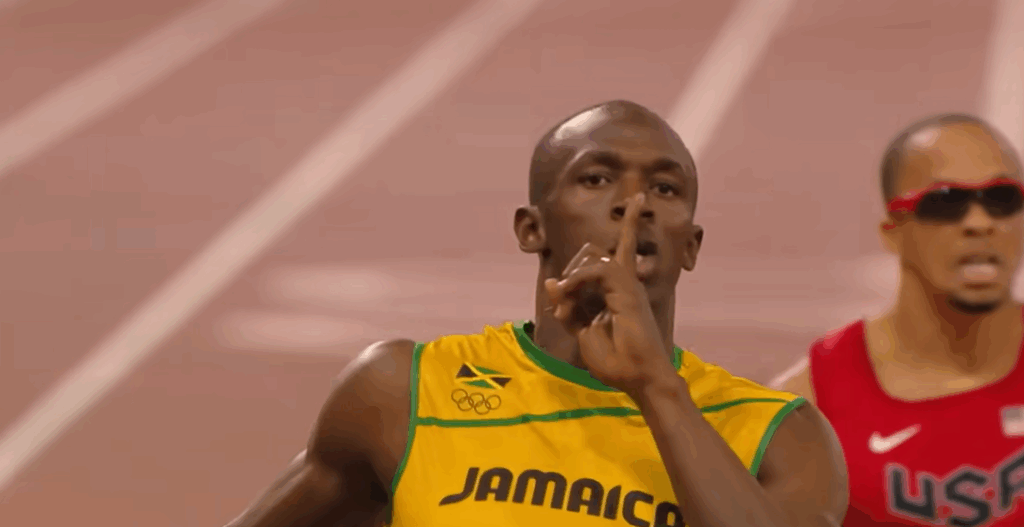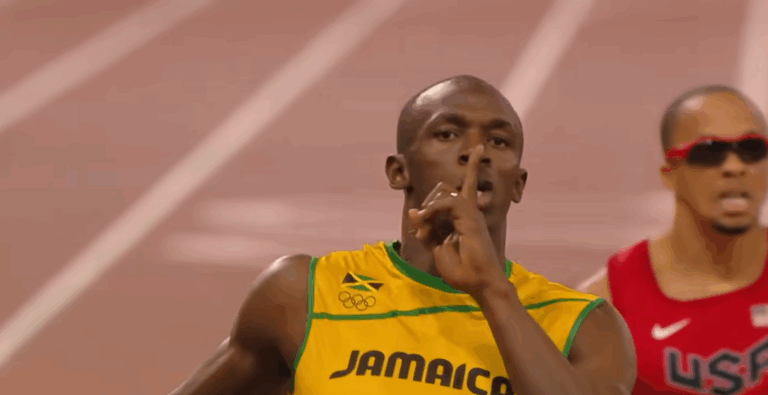Nearly as iconic as his world-record times is Usain Bolt’s height of 1.95 meters, or 6 feet 5 inches. Sports scientists and track fans have been debating whether his extraordinary height gave him an unfair advantage or if it was just one component of a sophisticated, well-tuned machine for years. Bolt proved that greatness frequently results from rewriting expectations rather than playing by them. He was remarkably successful at maximizing stride length without sacrificing speed.
By the time he was fifteen, Bolt was already well above his peers in terms of height. He clearly dominated the competition at the 2002 World Junior Championships in Kingston, drawing attention with his physique and form. But it was more than just show; it was substance. His height eventually became a fundamental component of his sprinting technique. It proved especially helpful once he reached top speed, contrary to what some doubters thought it would slow him down.
The majority of sprinters thrive on quick, forceful leg movements. They take 45 to 50 steps to cover 100 meters. A bolt? In 41, he completed it. His strides were noticeably longer and more efficient, which is why the number was so much lower than it would have been if he had a faster leg turnover. The outcome? Despite appearing effortless on camera, this combination of strength and grace had its roots in physiological uniqueness.
Usain Bolt – Personal and Athletic Profile
| Attribute | Details |
|---|---|
| Full Name | Usain St. Leo Bolt |
| Date of Birth | August 21, 1986 |
| Age | 38 (as of 2025) |
| Nationality | Jamaican |
| Birthplace | Sherwood Content, Trelawny Parish, Jamaica |
| Height | 1.95 m (6 ft 5 in) |
| Weight | 94 kg |
| Profession | Retired Sprinter |
| Nickname | “Lightning Bolt” |
| Records Held | 100m (9.58s), 200m (19.19s), 4x100m Relay (36.84s) |
| Olympic Gold Medals | 8 |
| Coach | Glen Mills |
| Turned Pro | 2004 |
| Retired | 2017 (after World Championships) |
| Partner | Kasi Bennett |
| Daughter | Olympia Lightning Bolt |
| Reference Link | www.wikipedia.org/wiki/Usain_Bolt |

Being 6’5″ should be a disadvantage by sprinting standards, according to former British sprinter Craig Pickering. Because of their longer limbs and slower initial turnover, taller runners frequently have trouble accelerating. However, Bolt surmounted this obstacle thanks to his remarkable ground reaction force and a unique genetic balance of fast-twitch muscle fibers. Although he may have taken a little longer to accelerate, his cruising speed was still much faster than his rivals’. His legs seemed to be moving him automatically once he opened up.
Bolt’s short contact time with the track—just 0.08 seconds per footfall at top speed—is extremely efficient when viewed through the performance science lens. An amateur runner, on the other hand, makes contact for about 0.12 seconds. Over a distance of 100 meters, this seemingly insignificant difference has an exponential effect. Gold medals and standing ovations resulted from the time he saved by taking fewer steps. His goal in sprinting was to establish a rhythm that would make his height a positive asset rather than a mechanical drawback.
Bolt’s dominance over the last ten years has made coaches and analysts reconsider how to find talent. Taller athletes used to be directed toward volleyball or basketball. However, Bolt’s performances demonstrated beyond a reasonable doubt that height could be converted into explosive short-distance speed with the correct biomechanics and training. The way young athletes are scouted has significantly improved as a result of this change, providing more space for a variety of body types to literally find their lanes.
In addition to his athletic prowess, Bolt’s size greatly enhanced his brand. His legendary status on the track translated into international marketing and cultural impact. Bolt was constantly the star of the show when he stood next to other Olympians like swimmer Michael Phelps, Justin Gatlin, or even Tyson Gay. There was an aura to that physical presence that was impossible to ignore, especially during podium ceremonies or pre-race warm-ups.
Bolt’s public persona—a towering figure with unparalleled speed and captivating charisma—became a relatable representation of potential. He dispelled the fear that frequently accompanies tall figures with his flamboyant revelries and easygoing demeanor. Rather, he extended an invitation to everyone to join him in celebrating. His height didn’t make him feel alone when he danced for the audience or pointed to the sky after winning; rather, it made the moment more joyful. Those he brought along for the ride.
Bolt motivated innumerable young athletes who had been told they were “too tall” for particular roles by transforming a perceived limitation into a strength. Although not always discussed, this social influence subtly changed the way that people talk about body expectations. Bolt’s story continues to strike a deep chord, especially in developing nations like Jamaica where athletic achievement is seen as a sign of opportunity.
Debates concerning his height frequently reappear in online forums and media commentary. People on Reddit and Twitter wonder if Bolt’s power was just physical. However, a closer look shows that although his height gave him advantages, his success was largely due to years of focused training, astute coaching from Glen Mills, and mental toughness that is uncommon at the top level. It was about everything working in unison, not just height.
Additionally, his story is remarkably similar to that of other outliers throughout the history of sports. Another Olympic legend, Michael Phelps, defied aquatic conventions with his unusual wingspan and flexible ankles. In both instances, seemingly unusual physical characteristics were shaped into unparalleled advantages. These athletes demonstrate to us that, when cultivated with vision and strategy, unusual builds can result in amazing accomplishments.
Bolt has continued to have a significant impact since his retirement in 2017, particularly among those who support body diversity in competitive sports. As he builds businesses and raises his daughter Olympia Lightning, he still interacts with fans and aspiring athletes. Her name’s symbolism alone supports


